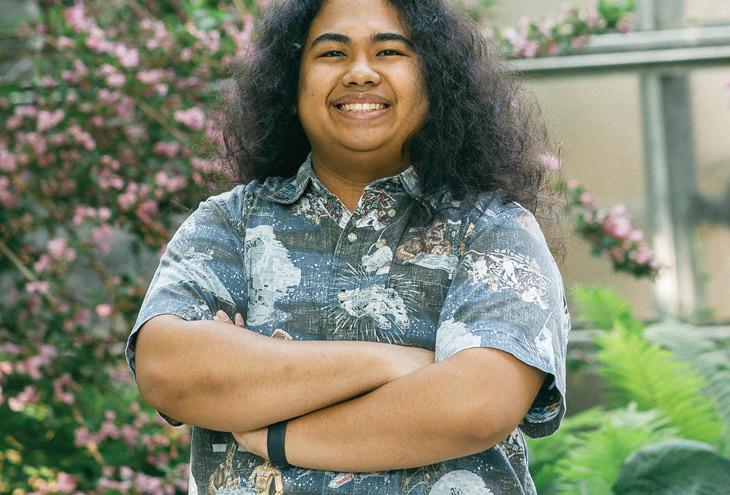Tobias-Jesiah Keohokapu found himself getting lost in the stars from a young age. Everything he’s discovered about astronomy since then, from learning about Polynesian wayfinding to studying special relativity and chaotic dynamics at college, has only increased his fascination. When he learned about the world travels of the Hōkūle’a, a double-hulled sailing canoe built as a modern replica of the vessels that brought the first Polynesian seafarers to Hawaii, he knew he had to study astronomy.
Keohokapu grew up on Oahu on a suburban cul-de-sac — a quiet street where he played with his four younger siblings. He lived in a multigenerational house that saw many relatives going in and out every day. His extended family is large, and he would see different cousins every weekend and spend holidays at the homes of different family members. “Our family even made the newspaper because we always go caroling as a group for Christmas,” he says.
The Kamehameha Schools — selective private college prep schools for Native Hawaiians — are famous in that community. “Pretty much every Native Hawaiian tests and interviews to try to get in,” says Keohokapu, “but I just never wanted to. They rejected me all the time, and I was over it.” He had switched from a private to a public school in eighth grade and had to make a whole new group of friends. He didn’t want to go through that process again, nor did he want to get another rejection. His parents told the interviewers that he was sick, and he didn’t go to testing.
A week later, Kamehameha called and asked if he wanted to reschedule. “I saw this as fate,” he says. “‘Maybe this time it will be different.’” It was different. He was accepted. He enrolled at Kamehameha Schools Kapālama campus, got over his fears, and made lifelong friends and connections. “I never wanted to go to Kamehameha, but it was probably the best decision of my life,” he says. Being at a school for Native Hawaiians taught him a lot about his culture and identity and helped him develop spiritually.
At Kamehameha Kapālama, he was introduced to AISES by his biology teacher, Ms. Ishimoto, winner of the 2018 AISES Educator Partner Award and an important influence on his academic trajectory. Keohokapu joined AISES, attended conferences, and presented research throughout the rest of his time at high school. His AISES connection came with both valuable experiences and many opportunities, and he’s grateful to Ms. Ishimoto for her help.
Moving halfway across the globe to attend Rochester Institute of Technology was something of a shock for Keohokapu. “Going from over 80 degrees to under 60 within a day was not something I thought could happen on Earth,” he says. “Besides the temperature, I never felt like I had a place for myself, and I still kind of don’t.”
He joined the RIT AISES College Chapter, where he was treasurer for a time. That community helped, but feeling socially isolated was still a challenge for him. “Academically I was keeping up fine,” he says, “but I never felt like I deserved to have a voice in any of my classes. My viewpoint was ‘what right do I have as someone who is not as smart as these people, or works as hard as these people, to ever really make it in life?’”
Moving halfway across the globe to attend Rochester Institute of Technology was something of a shock for Keohokapu. “Going from over 80 degrees to under 60 within a day was not something I thought could happen on Earth,” he says. “Besides the temperature, I never felt like I had a place for myself, and I still kind of don’t.”
He joined the RIT AISES College Chapter, where he was treasurer for a time. That community helped, but feeling socially isolated was still a challenge for him. “Academically I was keeping up fine,” he says, “but I never felt like I deserved to have a voice in any of my classes. My viewpoint was ‘what right do I have as someone who is not as smart as these people, or works as hard as these people, to ever really make it in life?’”













